
Broomhill and Sharrow Vale — which includes the districts of Broomhill, Broomhall, Crookesmoor, Endcliffe, Sharrow Vale and Tapton Hill — is one of the 28 electoral wards in City of Sheffield, England. The ward was created following the 2015 local government boundary review out of parts of the old Broomhill, Central and Nether Edge wards. It is located in the western part of the city. The population of the Broomhill ward in 2011 was 16,966 people in 5,708 households, covering an area of 2.7 km2. Broomhill & Sharrow Vale is one of the wards that make up the Sheffield Central Parliamentary Constituency.

Crosspool is a suburb of the City of Sheffield, South Yorkshire, England, located 2.5 miles (4 km) west of the city centre. The suburb falls within the Crookes ward of the City of Sheffield. It is a middle class residential area in an elevated position above the Porter and Rivelin valleys and stands at around 660 feet (200 m) above sea level. Crosspool is situated on the A57 road and is the last suburb on that road before the city boundary and open countryside is reached. In 2011 Crosspool had a population of 6,703.

Sir John Brown, British industrialist, was born in Sheffield. He was known as the Father of the South Yorkshire Iron Trade.

Whirlow is a suburb of the City of Sheffield in England, it lies 3.7 miles (6 km) south-west of the city centre. The suburb falls within the Dore and Totley ward of the City. It is one of the most affluent areas of Sheffield, with much high class housing and several notable small country houses within it. During the Victorian era it was home to some of Sheffield's most influential citizens. Whirlow straddles the A625, the main Sheffield to Hathersage road. The suburb covers the area from Parkhead in the north to Whirlow Bridge in the south and from Ecclesall Woods in the east to Broad Elms Lane in the west. Whirlow had a population of 1,663 in 2011.

Ranmoor is a suburb of the City of Sheffield, England. It is an affluent suburb in the Fulwood ward of the city. It mostly developed in the late 19th and early 20th centuries, and it features a number of large houses that were built for the city's steel magnates, as well as, most notably, a large church, St John's. This church was opened 24 April 1879 but was almost entirely destroyed by fire on 2 January 1887. All that survived from the original church was the tower and spire, which still stands today. A new building was built and the church reopened on 9 September 1888; it is now a Grade II* listed building. A row of early 19th century buildings near the church includes the Bull's Head and Ranmoor Inn public houses.
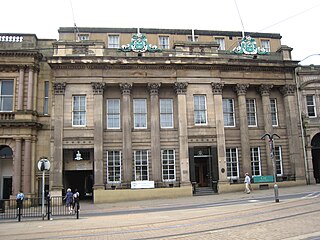
Cutlers' Hall is a Grade II* listed building in Sheffield, England, that is the headquarters of the Company of Cutlers in Hallamshire. It is located on Church Street, opposite Sheffield Cathedral, in Sheffield City Centre.
This timeline of Sheffield history summarises key events in the history of Sheffield, a city in England. The origins of the city can be traced back to the founding of a settlement in a clearing beside the River Sheaf in the second half of the 1st millennium AD. The area had seen human occupation since at least the last ice age, but significant growth in the settlements that are now incorporated into the city did not occur until the industrial revolution.

The Globe Works are a former cutlery factory situated in the City of Sheffield, South Yorkshire, England on Penistone Road in the suburb of Neepsend. The Works are a Grade II* Listed Building which in the late 1980s were renovated to provide modern office space. It is part of the Kelham Island Conservation Area.

The Mount is a Grade II* listed building situated on Glossop Road in the Broomhill area of Sheffield in England. It stands just over 1.3 miles (2.1 km) west of the city centre. It is a neoclassical building which was originally a terrace of eight houses but since the 1950s has been used for commercial office space for various businesses. The building is part of the Broomhill Conservation Area, which was set up in March 1977 through an agreement with local residents and Sheffield City Council.

Tapton Hall is a Grade II listed building situated on Shore Lane in the Crosspool area of Sheffield, England.

Mount Pleasant is an 18th-century mansion situated on Sharrow Lane in the Highfield area of the City of Sheffield in South Yorkshire, England. The house stands just under two km south of the city centre and is a grade II* listed building, it has been described as "one of the best 18th century houses in Sheffield". The adjacent former stables and coach house are also Grade II* listed.

Upperthorpe is a suburb of the City of Sheffield, England. It lies 1.2 miles (2 km) west of the city centre. The suburb falls within the Walkley ward of the City. It is an area of residential housing and is bounded by the suburbs of Walkley to the north, Crookes to the west and Netherthorpe to the south.

Oakes Park is a privately owned, historic park land in the green-belt area of south Sheffield. It contains 15 private homes as well as a 17th-century English country house which now operates as The Oakes Holiday Centre, a Christian, residential activity centre for young people between the ages of 8 and 18. It is set in extensive grounds which make it very difficult to be seen by the general public. It is situated on Norton Lane in the suburb of Norton within the City of Sheffield in England. The house is a Grade II* listed building, as are several other buildings and features.

Norton Hall is an English country house situated on Norton Church Road in the suburb of Norton in Sheffield, England. For most of its history it has been a private residence, in its latter history it has been used as a NHS hospital, a private hospital and has now been converted into high quality apartments. It is a Grade II* listed building.
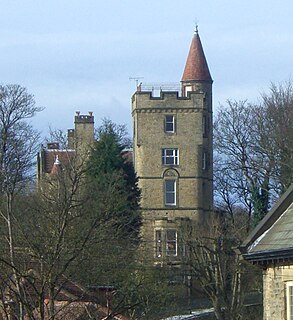
The Towers is a small English country house situated in Sheffield, England. The house stands on Sandygate Road close to the junction with Coldwell Lane in the suburb of Crosspool. It is a Grade II listed building as is the lodge and attached gateway and the concave garden wall. It has been described as “an extraordinary Scottish baronial fantasy”.

Stumperlowe Hall is a small English country house situated in the City of Sheffield, England. It is located on Stumperlowe Hall Road at its junction with Slayleigh Lane in the suburb of Fulwood. The hall is a Grade II listed building.

Fulwood Hall, is an English country house situated on Harrison Lane in the suburb of Fulwood in Sheffield, England. It is a Grade II listed building. The hall stands in a lofty position on the north side of the Mayfield Valley at a height of 270 metres. The hall is referred to as Fullwood Hall on old maps and the gate to the hall uses this spelling with two Ls.
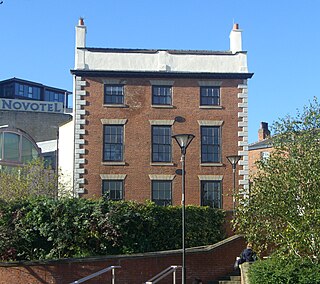
Leader House is a Georgian townhouse located on Surrey Street in the city centre of Sheffield, England. It overlooks the busy Arundel Gate dual carriageway and is a Grade II listed building.
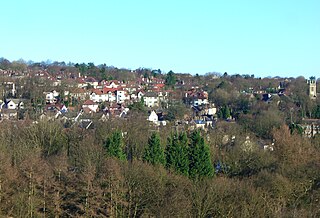
Fulwood is a residential suburb and ward of the City of Sheffield in England, it lies 5.5 km west-southwest of the city centre. Formerly an ancient settlement and village on the Porter Brook, it became integrated into the city in the 1930s. It is bounded by the suburbs of Lodge Moor to the NW, Ranmoor to the east and Crosspool to the NE. The open countryside of the Peak District lies to the west and SW. The sub districts of Stumperlowe and Goole Green are part of the suburb. The population of the ward at the 2011 Census was 18,233. Fulwood is located in the Sheffield Hallam constituency which, as of the 2019 general election voted Labour.
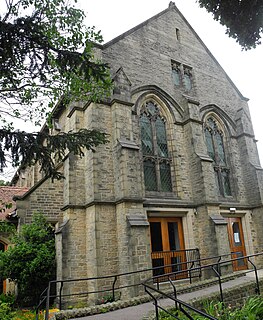
John Dodsley Webster (1840–1913) was an English architect who designed more than 15 churches in Sheffield in various Gothic styles, usually working to a tight budget. His work also included hospitals and commercial buildings, small country houses and private houses. All his known work was carried out in the South Yorkshire and North Derbyshire area except for a chapel and school built in Coventry.


















